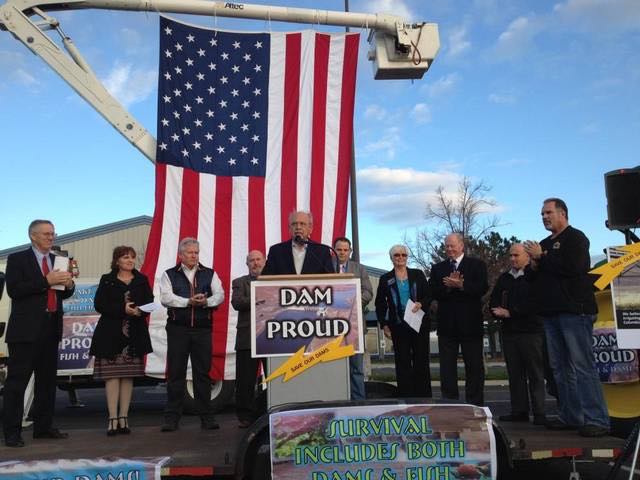forum
library
tutorial
contact

People Passionate About
Saving Snake River Dams
by Annette Cary
Tri-City Herald, November 21, 2016
|
the film forum library tutorial contact |

|
People Passionate About
by Annette Cary
|
"I thought this had already been resolved."
-- Jake MacCormick of Kennewick
 There are few things that get Bob Cummings of West Richland more riled up that the idea of taking out the four lower Snake River dams.
There are few things that get Bob Cummings of West Richland more riled up that the idea of taking out the four lower Snake River dams.
"The idea of breaching the dams is so stupid it doesn't even warrant discussion," he said after submitting comments at a Pasco public meeting Monday. The focus of the session was what should be included in a new study of the Columbia and Snake rivers dams and their reservoirs. More than 300 people showed up.
Taking out the four dams would have huge negative impacts, both on the economy and the environment, he said. Power generation systems capable of replacing them would not be as environmentally friendly, he said.
The dams play a key role in the Eastern Washington economy, said those who spoke at a news conference before the meeting.
"This is not about policy," said retired Rep. Doc Hastings, R-Wash. "This is about politics and it is (politics) largely by people who live outside this area."
The Army Corps of Engineers scheduled 16 meetings around the Northwest to gather input on the new study, called an environmental impact statement.
At meetings so far, the Corps has heard from people passionate about the benefits they are receiving and those they could lose, but also from people passionate about endangered fish species in the Columbia and Snake rivers and about endangered killer whales that feed on salmon in Washington state waters, said Rebecca Weiss, the Corps program coordinator for the study.
The study was required by U.S. Judge Michael Simon in Portland after the federal government's latest plan for protecting threatened and endangered salmon did not consider whether breaching one or more Snake River dams would save wild salmon.
The issue was personal for Dan and Linda Voss, who farm in Franklin County and left comments at the Pasco meeting. They are the second of three generations of their family to farm.
Their well driller has warned them that the aquifer level where they farm five miles northwest of Ice Harbor Dam is linked to river levels, Dan Voss said.
If the lake behind the dam is gone, their wells might no longer yield the water they depend on for irrigation, said Linda Voss. The family also enjoys water skiing behind Ice Harbor Dam.
"I thought this had already been resolved," said Jake MacCormick of Kennewick. "I don't understand why it is back again."
Fish ladders at the dams have led to record fish returns, he said.
"Any new science that is developed in regard to safer, better fish passage past dams should be implemented," said Corrin Rathbun, a retired farmer and the owner of a Franklin County farm. "In no circumstances should the dams be removed. There are too many economic benefits to the dams."
Before the meeting, Bill Dress, owner of Ranch and Home stores, said people from all over the country come to Eastern Washington to go fishing, spending money at restaurants, hotels and stores.
Ranch and Home has quadrupled the size of its fishing department in the last six years "and we didn't do it because fish weren't here," he said.
Nearly 60 percent of all the energy produced in Washington, Oregon, Idaho and Montana is generated by hydropower dams on the Columbia and Snake rivers, said Roger Wright, Franklin Public Utility District commissioner.
The dams are needed to back up other renewables, like wind and solar that are intermittent, he said.
"I'm assuming all of you want your power more than 30 percent of the time," he said.
The regional economy was built and continues to thrive because of the abundant, low cost renewable energy produced by the dams, said Jean Ryckman, Port of Pasco commissioner,
The Columbia and Snake rivers allow Northwest farmers and industry to barge more than 9 million tons of commercial cargo each year faster and with less fuel than trucks or train would use, she said.
"The marine highway that was created by the dams and river system is the most environmentally friendly way to move cargo," she said.
Comments can be submitted on the scope of the planned study until Jan.17 at www.crso.info, by email to comment@crso.info or by mail to U.S. Army Corps of Engineers, Attn: CRSO EIS, P.O. Box 2870, Portland, OR, 97208-2870.
A draft study is expected to be finished sometime between fall 2019 and March 2020, with another chance for the public to comment when it is released. The final study should take an additional year.
learn more on topics covered in the film
see the video
read the script
learn the songs
discussion forum
